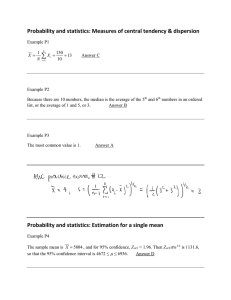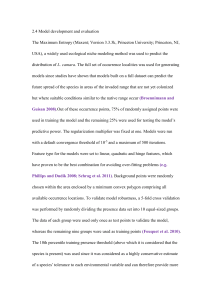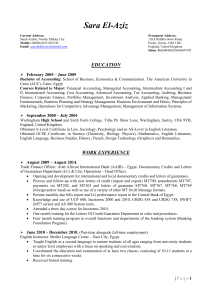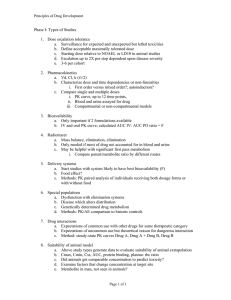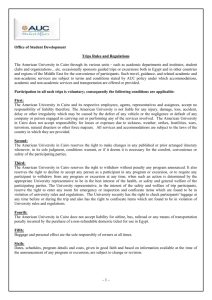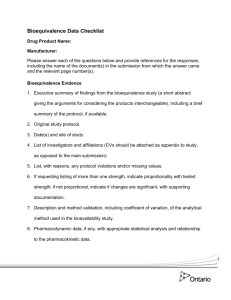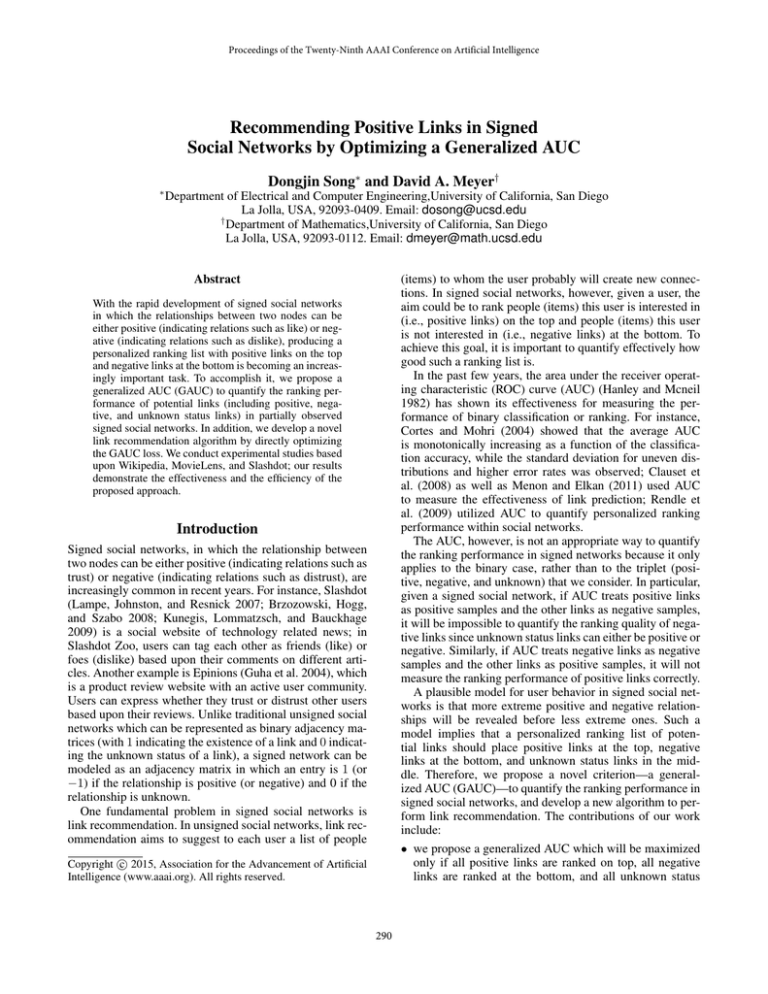
Proceedings of the Twenty-Ninth AAAI Conference on Artificial Intelligence
Recommending Positive Links in Signed
Social Networks by Optimizing a Generalized AUC
∗
Dongjin Song∗ and David A. Meyer†
Department of Electrical and Computer Engineering,University of California, San Diego
La Jolla, USA, 92093-0409. Email: dosong@ucsd.edu
†
Department of Mathematics,University of California, San Diego
La Jolla, USA, 92093-0112. Email: dmeyer@math.ucsd.edu
Abstract
(items) to whom the user probably will create new connections. In signed social networks, however, given a user, the
aim could be to rank people (items) this user is interested in
(i.e., positive links) on the top and people (items) this user
is not interested in (i.e., negative links) at the bottom. To
achieve this goal, it is important to quantify effectively how
good such a ranking list is.
In the past few years, the area under the receiver operating characteristic (ROC) curve (AUC) (Hanley and Mcneil
1982) has shown its effectiveness for measuring the performance of binary classification or ranking. For instance,
Cortes and Mohri (2004) showed that the average AUC
is monotonically increasing as a function of the classification accuracy, while the standard deviation for uneven distributions and higher error rates was observed; Clauset et
al. (2008) as well as Menon and Elkan (2011) used AUC
to measure the effectiveness of link prediction; Rendle et
al. (2009) utilized AUC to quantify personalized ranking
performance within social networks.
The AUC, however, is not an appropriate way to quantify
the ranking performance in signed networks because it only
applies to the binary case, rather than to the triplet (positive, negative, and unknown) that we consider. In particular,
given a signed social network, if AUC treats positive links
as positive samples and the other links as negative samples,
it will be impossible to quantify the ranking quality of negative links since unknown status links can either be positive or
negative. Similarly, if AUC treats negative links as negative
samples and the other links as positive samples, it will not
measure the ranking performance of positive links correctly.
A plausible model for user behavior in signed social networks is that more extreme positive and negative relationships will be revealed before less extreme ones. Such a
model implies that a personalized ranking list of potential links should place positive links at the top, negative
links at the bottom, and unknown status links in the middle. Therefore, we propose a novel criterion—a generalized AUC (GAUC)—to quantify the ranking performance in
signed social networks, and develop a new algorithm to perform link recommendation. The contributions of our work
include:
With the rapid development of signed social networks
in which the relationships between two nodes can be
either positive (indicating relations such as like) or negative (indicating relations such as dislike), producing a
personalized ranking list with positive links on the top
and negative links at the bottom is becoming an increasingly important task. To accomplish it, we propose a
generalized AUC (GAUC) to quantify the ranking performance of potential links (including positive, negative, and unknown status links) in partially observed
signed social networks. In addition, we develop a novel
link recommendation algorithm by directly optimizing
the GAUC loss. We conduct experimental studies based
upon Wikipedia, MovieLens, and Slashdot; our results
demonstrate the effectiveness and the efficiency of the
proposed approach.
Introduction
Signed social networks, in which the relationship between
two nodes can be either positive (indicating relations such as
trust) or negative (indicating relations such as distrust), are
increasingly common in recent years. For instance, Slashdot
(Lampe, Johnston, and Resnick 2007; Brzozowski, Hogg,
and Szabo 2008; Kunegis, Lommatzsch, and Bauckhage
2009) is a social website of technology related news; in
Slashdot Zoo, users can tag each other as friends (like) or
foes (dislike) based upon their comments on different articles. Another example is Epinions (Guha et al. 2004), which
is a product review website with an active user community.
Users can express whether they trust or distrust other users
based upon their reviews. Unlike traditional unsigned social
networks which can be represented as binary adjacency matrices (with 1 indicating the existence of a link and 0 indicating the unknown status of a link), a signed network can be
modeled as an adjacency matrix in which an entry is 1 (or
−1) if the relationship is positive (or negative) and 0 if the
relationship is unknown.
One fundamental problem in signed social networks is
link recommendation. In unsigned social networks, link recommendation aims to suggest to each user a list of people
• we propose a generalized AUC which will be maximized
only if all positive links are ranked on top, all negative
links are ranked at the bottom, and all unknown status
c 2015, Association for the Advancement of Artificial
Copyright Intelligence (www.aaai.org). All rights reserved.
290
networks and develop a model to perform link recommendation by directly minimizing the loss of GAUC.
links are in the middle.
• we develop a link recommendation approach by directly
minimizing the loss of the proposed GAUC; the proposed model enjoys both low computational complexity
and high memory efficiency.
A Generalized AUC
In this section, we first introduce the area under the ROC
curve (AUC) and then present a generalized AUC to measure
the ranking performance in signed networks.
• we conduct experimental studies based upon three real
world datasets, i.e., Wikipedia, MovieLens, and Slashdot; the results demonstrate the effectiveness of the generalized AUC for quantifying link recommendation in
signed social networks; the results also demonstrate the
efficiency and the effectiveness of the proposed approach.
AUC
Given a binary classifier f and a training set (ai , bi )ni=1 with
ai ∈ Rd and bi ∈ {−1, 1}, let P = {ai | bi = 1} be the
set of positive samples and N = {ai | bi = −1} the set of
negative samples. Then the AUC is defined by:
X X
1
AUC =
I f (ai ) > f (aj )
(1)
|P||N |
Related Work
In the past few years, various approaches (Heider 1946; Doreian and Mrvar 2009; Leskovec, Huttenlocher, and Kleinberg 2010a; 2010b; Dong et al. 2012; Yang et al. 2012;
Ye et al. 2013; Song and Meyer 2014) have been developed to investigate signed social networks. Among these
approaches, while most of them concentrate on edge sign
prediction and community detection, few have focussed on
link recommendation. Although the link recommendation
problem in signed social networks is more difficult than in
conventional unsigned social networks, we review related
work in the conventional setting to motivate our proposed
approach. In general, there are two types of link recommendation approaches in unsigned social networks. One uses
network topology and another is model-based.
Network topological approaches recommend links based
upon the network topological structure. For instance, LibenNowell and Kleinberg (2007) showed that common neighbors, Jaccard’s coefficient, and Adamic/Adar (Adamic and
Adar 2003) can be used for link prediction and recommendation; Katz (1953), which measures the ensemble of all paths,
also demonstrated its effectiveness for link prediction and
recommendation. These approaches, however, cannot perform link recommendation effectively when little network
topological information is available, which often happens in
real world sparse social networks.
To tackle this issue, model-based approaches have been
developed. Specifically, there are two types of model-based
methods. One is pointwise approaches, such as singular
value decomposition (SVD), non-negative matrix factorization (NMF) (Lee and Seung 1999; Song, Meyer, and Min
2014), probabilistic matrix factorization (Salakhutdinov and
Mnih 2007), and matrix factorization (MF) (Koren, Bell,
and Volinsky 2009), which aim to reconstruct the network
adjacency matrix with a low rank approximation. Another
is pairwise approaches, such as maximum margin matrix
factorization (Weimer, Karatzoglou, and Smola 2008) and
Bayesian personalized ranking (BPR) (Rendle et al. 2009),
which aim to provide a personalized ranking list based upon
pairwise comparisons.
Although most of these approaches can be applied directly for link recommendation in signed social networks,
they may not perform well because their objectives are inconsistent with that of link recommendation in signed networks. Therefore, we introduce a generalized AUC (GAUC)
to quantify the personalized ranking performance in signed
ai ∈P aj ∈N
where I(·) is an indicator function which is 1 if the condition in the parenthesis is satisfied and 0 otherwise; |P| and
|N | are the numbers of positive samples and negative samples, respectively. AUC is the value of the Wilcoxon-MannWhitney statistic (Hanley and Mcneil 1982) which is essentially the probability that a random element of one set f (ai )
is larger than a random element of another f (aj ). With an
ideal ranking list, AUC should be 1 representing each positive sample is ranked higher than all the negative samples.
For a random ranking, AUC will be 0.5.
A Generalized AUC
Given a signed social network which contains positive, negative, and unknown status links, an ideal personalized ranking list tends to rank positive links (indicating a relationship
such as trust) on the top, negative links (indicating a relationship such as distrust) at the bottom, and unknown status links in the middle. Traditional AUC, however, cannot
quantify such a ranking list appropriately because it considers only the binary case. For instance, if AUC treats positive
links as positive examples and the other links as negative
examples, it cannot quantify the ranking quality of negative
links since unknown status links could be either positive or
negative. Similarly, if AUC treats negative links as negative
samples and the others as positive samples, it cannot measure the ranking quality of positive links.
Note that although mean average precision (MAP) and
normalized discounted cumulative gain (NDCG) can be
used to measure ranking performance in signed networks,
they may not perform well because they tend to overestimate
the positive links on the top and cannot quantify the negative
links appropriately, because we aim to rank them at the bottom of the ranking list and there are much more unknown
status links than negative links in real world applications.
To resolve these issues, we develop a novel criterion,
named generalized AUC (GAUC), to measure the ranking
performance in signed networks based upon the assumption that more extreme positive and negative relationships
will be revealed before less extreme ones. Specifically, suppose we are given a classifier f and a training set (ai , bi )ni=1
with ai ∈ Rd the ith sample, bi ∈ {−1, 0, 1} its label.
291
Let P = {ai | bi = 1} be the set of positive samples,
N = {ai | bi = −1} be the set of negative samples, and
O = {ai | bi = 0}. Then GAUC can be defined as:
η
GAUC =
|P|(|O| + |N |)
+
1−η
|N |(|O| + |P|)
X
X
ai ∈P as ∈O
X
at ∈O
S
S
is memory efficient can be employed to obtain the ranking
score as follows:
f (i, j, U, V ) = f (Ui , Vj ) = UiT Vj
where Ui ∈ Rr , Vj ∈ Rr , and r is the rank (r n).
Link Recommendation Model
I f (ai ) > f (as )
N
X
I f (aj ) < f (at )
Since GAUC is a reasonable way to quantify the ranking
performance in signed social networks, an ideal link recommendation model would be expected to optimize GAUC directly. Based upon the low rank model in Eqn. (5), the loss
of GAUC can be defined as:
P aj ∈N
(2)
where |P| denotes the number of positive samples, |N | represents the number of negative samples, and |O| is the number of unknown status samples. The first and second terms
quantify the ranking performance of positive links and negative links, respectively. 0 ≤ η ≤ 1 is a parameter which
controls the tradeoff between these two terms. In this work,
|P|
we set η = |P|+|N
| , i.e., the tradeoff is controlled by the
relative fraction of the number of positive links and that of
negative links. After substituting η in Eqn. (2), we can obtain
GAUC =
X
1
1
(|P| + |N |) (|O| + |N |) a ∈P
i
1
> f (as ) +
(|O| + |P|)
X
X
aj ∈N at ∈O
S
(5)
X
as ∈O
S
1 − GAUC(U, V ) =
1
1
(|P| + |N |) (|O| + |N |)
≤
1
+
(|O| + |P|)
X
Xij ∈P Xis ∈O
X
T
I(Ui Vj
S
X
Xij ∈N Xis ∈O
(6)
N
T
I(Ui Vj
S
≥
T
Ui Vs )
.
P
Since the indicator function I(·) is non-convex, hinge loss
can be used as a convex surrogate in Eqn. (6). Therefore, an
upper bound of GAUC loss can be derived based upon the
following two inequalities (as shown in Figure 1):
I f (ai )
N
I f (aj ) < f (at )
T
Ui Vs )
X
.
P
I(UiT Vj ≤ UiT Vs ) ≤ max 0, UiT (Vs − Vj ) + 1) ,
(7)
I(UiT Vj ≥ UiT Vs ) ≤ max 0, UiT (Vj − Vs ) + 1) .
(8)
(3)
and
Like the AUC, GAUC will be 1 if we have a perfect ranking list and will be 0.5 if we have a random ranking list.
The main difference between them is that GAUC can jointly
quantify the ranking quality over positive links and negative
links, in the presence of unknown links. We are aware that
different variants of AUC (Nakas and Yiannoutsos 2004;
Li 2009) have been developed in the past. GAUC differs
from these variants by focusing on the head and tail of a
ranking list.
Assuming |O| |P| and |O| |N | which holds for real
world sparse signed graphs, the upper bound of GAUC loss
can be written as the following objective:
Q(U, V ) =
n X
n X
n
X
max 0, UiT (Vs − Vj ) + 1) ·
i=1 j=1 s=1
I(Xij = 1, Xis 6= 1) + λU
Optimizing the Generalized AUC
X
UiT Ui +
i
In this section, we first state the problem we aim to study.
Then, we propose a novel model for link recommendation by
directly minimizing the loss of GAUC. Finally, we introduce
an optimization procedure for our proposed approach.
n X
n X
n
X
(9)
max 0, UiT (Vj − Vs ) + 1) ·
i=1 j=1 s=1
I(Xij = −1, Xis 6= −1) + λV
X
VjT Vj
j
Problem Statement
where the second and fourth terms are regularization terms
used for preventing over-fitting. λU and λV are two hyperparameters for controlling the scale of regularization terms.
Suppose we are given a partially observed signed network
X ∈ Rn×n with Xij ∈ {1, −1, 0, ?}, where 1 denotes a
positive link, −1 represents a negative link, 0 is an unknown
status link, and ? denotes a potential positive or negative
link. In the training stage, we treat both 0 and ? as zero
(i.e., potential links) and study the underlying mechanism
for ranking observed positive links on the top and negative
links at the bottom. In the test phase, we evaluate how these
potential links are ranked based upon the relative positions
of potential positive and negative links.
We aim to learn a mapping function f such that a ranking
score for the link at i-th row and j-th column of X can be
produced as
d
(4)
f (i, j, X) = X
ij .
Since many real world signed social networks are sparse
graphs with low rank structure, a low rank model which
Optimization
Although Q(U, V ) is non-convex and non-smooth with respect to U and V , a sub-gradient method can be employed
to minimize the objective over U and V alternately. Specifically, the partial derivative of Q(U, V ) given Ui is:
∂Q(U, V )
=
∂Ui
P
P
n
n
j=1
s=1 (Vs − Vj ) + λU Ui ,
P
P
n
n
j=1
s=1 (Vj − Vs ) + λU Ui ,
λU Ui ,
if Xij = 1, Xis 6= 1,
and UiT (Vs − Vj ) > −1;
if Xij = −1, Xis 6= −1,
and UiT (Vj − Vs ) > −1;
otherwise
(10)
292
Table 1: The statistics of two datasets.
Algorithm 1 Optimization of Q(U, V )
Input: X, U , V , α, number of batches b, number of iterations t,
threshold ς, maximum iteration T .
Initialize: set t = 0, initialize U0 and V0 randomly
repeat
t = t + 1;
t ,Vt )
based upon Eqn. (10);
Calculate ∂Q(U
∂Ut
Datasets
Nodes
Edges
+edges
−edges
Density
t ,Vt )
Ut+1 = Ut − α ∂Q(U
;
∂Ut
∂Q(Ut ,Vt )
based
∂Vt
∂Q(Ut ,Vt )
Vt − α ∂Vt ;
Calculate
Vt+1 =
until |Q(Ut+1 , Vt+1 ) − Q(Ut , Vt )| < ς or t > T
Figure 1: Convex surrogate Figure 2: The efficiency
loss of I(z ≥ 0).
of the proposed approach.
Slashdot
82,144
549,202
77.4%
22.6%
0.000081
Evaluation Metrics
Given a fully observed signed social network X ∈ Rn×n
with Xij ∈ {1, −1, 0}, we randomly remove a fraction
(80%, 60% and 40%) of positive and negative links and use
the rest to form a partially observed network for training (as
XTrain ). The zero entries in XTrain are called potential links
because they could either be positive or negative in the future. The removed links form a test set XTest .
To evaluate the effectiveness of the proposed model for
link recommendation, we utilize GAUC (over 1, −1, and 0)
in Eqn. (3), AUC (over 1 and −1) in Eqn. (1), and mean average precision (MAP) (over 1 and −1) to quantify the ranking performance over XTest . To evaluate the effectiveness
of top-k link recommendation, we also report its associated
average Recall@k and average Precision@k for reference.
Specifically, Recall@k is defined as:
the partial derivative of Q(U, V ) given Vj is:
if Xij = 1, Xis 6= 1,
and UiT (Vs − Vj ) > −1;
if Xij = −1, Xis 6= −1,
and UiT (Vj − Vs ) > −1;
otherwise
(11)
and the partial derivative of Q(U, V ) given Vs is:
∂Q(U, V )
=
∂V
Psn Pn
i=1
j=1 Ui + λV Vs ,
P
Pn
− n
i=1
j=1 Ui + λV Vs ,
λV Vs ,
MovieLens
6040/3952
739,012
77.84%
22.16%
0.0309
dot (Lampe, Johnston, and Resnick 2007) 1 . The Wikipedia
data comprise a voting network for promoting candidates to
the role of admin. Slashdot is a social website focusing on
technology related news. In Slashdot Zoo, users can tag each
other as friends (like) or foes (dislike) based upon comments
on articles.
We also consider Movielens 1M dataset2 which contains
6040 users as well as 3952 items. Although this dataset is
mainly used for collaborative filtering, we preprocess it so
that ratings of 4 and 5 are treated as positive links, ratings
of 1 and 2 are treated as negative links, and other ones are
treated as unknown status links.
The detailed statistics of these three datasets are provided
in Table 1.
upon Eqn. (11) and Eqn. (12);
∂Q(U, V )
=
∂Vj
P
Pn
n
− i=1 s=1 Ui + λV Vj ,
P
Pn
n
i=1
s=1 Ui + λV Vj ,
λV Vj ,
Wikipedia
7,118
103,747
78.78%
21.21%
0.0020
if Xij = 1, Xis 6= 1,
and UiT (Vs − Vj ) > −1;
if Xij = −1, Xis 6= −1,
and UiT (Vj − Vs ) > −1;
otherwise.
(12)
Recall@k =
#positive links in the top k
,
#positive links
and Precision@k is given as
Precision@k =
For practical applications, the size (or the number of the nonzero entries) of sparse signed networks maybe too large to
handle. In this case, stochastic sub-gradient descent can be
employed. In particular, assuming |O| |P| and |O| |N |, let q = |P| + |N | and b be the number of batches. The
)
)
computational complexity of ∂Q(U,V
(or ∂Q(U,V
) will be
∂U
∂V
n(q+r)
O( b ). The specific optimization procedure is shown in
Algorithm 1.
#positive links in the top k
.
#positive links and negative links in the top k
Parameter Setting
There are three hyper-parameters in our model, i.e., λU ,
λV , and k. We set λU = λV for simplicity and search
over the grid of {1, 5, 10, 20, 50, 100, 200} to find the optimal setting for λU and λV . We also search over the grid of
{10, 30, 50, 70, 90} to find the optimal setting for k. Specifically, we conduct 5 fold cross-validation on Xtrain and
Experiment
1
These datasets are available online at
http://snap.stanford.edu/data/.
2
This dataset is available online at
http://grouplens.org/datasets/movielens/.
Datasets
We consider two well-known signed directed social networks, i.e., Wikipedia (Burke and Kraul 2008) and Slash-
293
(a) GAUC on Wikipedia.
(b) GAUC on MovieLens.
(c) GAUC on Slashdot
Figure 3: GAUC on Wikipedia, MovieLens, and Slashdot. Error bars represent the standard deviations of uncertainty.
(a) AUC on Wikipedia.
(b) AUC on MovieLens
(c) AUC on Slashdot
Figure 4: AUC on Wikipedia, MovieLens, and Slashdot. Error bars represent the standard deviations of uncertainty.
(a) MAP on Wikipedia.
(b) MAP on MovieLens.
(c) MAP on Slashdot
Figure 5: MAP on Wikipedia, MovieLens, and Slashdot. Error bars represent the standard deviations of uncertainty.
the parameter combination which achieves the best average
GAUC is employed for test.
associated standard deviations are reported for comparison.
Efficiency: We study the efficiency of the proposed approach by employing stochastic sub-gradient descent over
20% of the Wikipedia dataset. In particular, we partition
XTrain into b batches and perform sub-gradient descent
over U and V iteratively. Figure 2 shows the efficiency of
the proposed approach with different numbers of batches
(b ∈ {5, 10, 30, 60}). We observe that when b varies from 5
to 60, the objective function of our proposed approach converges faster. This is because the computational complexity
of the sub-gradients linearly depends on b. Moreover, we observe that the GAUC/AUC/MAP does not decay very much
while b is increasing.
Results
Baslines: We compare the proposed approach
(OPT+GAUC) with various baseline approaches to
demonstrate its effectiveness. Among these baselines,
common neighbor (CN) (Liben-Nowell and Kleinberg
2007) and Katz (Katz 1953) are obtained based upon
the network topological structure; singular value decomposition (SVD) and matrix factorization (MF) (Koren,
Bell, and Volinsky 2009) are two representative pointwise
approaches for collaborative filtering; maximum margin
matrix factorization (MMMF) (Weimer, Karatzoglou, and
Smola 2008) and Bayesian personalized ranking based
upon matrix factorization (BPR+MF) (Rendle et al. 2009)
are two popular pairwise approaches for personalized
ranking. For fair comparison, β in Katz is set as 0.005
because it achieves the best performance; we select the
hyper-parameters of MF, MMMF, and BRP+MF in a similar
way as we do for OPT+GAUC. To ensure our results are
reliable, we conduct each experiment 5 times; the average GAUC/AUC/MAP/Recall@k/Precision@k and their
Link recommendation: Figures 3, 4, and 5 show the
GAUC/AUC/MAP and their associated standard deviations
of various approaches on three datasets when the size of
training set varies from 20% to 60%. We observe that CN is
generally outperformed by other approaches because it only
considers the neighborhood structure of the network; since
Katz not only encodes neighborhood structure but also considers the high-order relationships, it can outperform CN in
most cases. Note that CN and Katz cannot work on MovieLens because it is a bipartite network. For GAUC in Fig-
294
(a) Precision@k on Wikipedia.
(b) Precision@k on MovieLens.
(c) Precision@k on Slashdot
Figure 6: Precision@k for Wikipedia, MovieLens, and Slashdot. Error bars represent the standard deviations of uncertainty.
(a) Recall@k on Wikipedia.
(b) Recall@k on MovieLens.
(c) Recall@k on Slashdot
Figure 7: Recall@k for Wikipedia, MovieLens, and Slashdot. Error bars represent the standard deviations of uncertainty.
(a) GAUC on 20%Wikipedia.
(b) AUC on 20%Wikipedia.
(c) MAP on 20%Wikipedia.
Figure 8: Parameter sensitivity study for Wikipedia (20% training) with respect to GAUC, AUC, and MAP.
ure 3, we observe that, pairwise approaches, i.e., MMMF
and BPR+MF, outperform pointwise approaches (i.e., SVD
and MF) in most cases. This may be because SVD tends
to over-fit the data and MF only reconstructs the partially
observed network based upon observed positive as well
as negative links (it neglects unknown status links). For
AUC and MAP, SVD cannot perform as well as MF because SVD tends to over-fit the data (especially for smaller
datasets); MMMF and BPR+MF are outperformed by MF
as they do not directly model negative links. On the contrary, they treat both negative and unknown status links as 0.
OPT+GAUC generally outperforms all baseline algorithms
regarding GAUC/AUC/MAP, this is because OPT+GAUC
models the triplet in signed networks more reasonably than
other approaches.
Top-k link recommendation: We further investigate the
effectiveness of the proposed approach by comparing its
Precision@k and Recall@k with baseline methods (the size
of training set is 40% for Wikipedia, MovieLens, and Slashdot) in Figure 6 and 7, respectively. We observe that while
OPT+GAUC is among the best approaches for Recall@k
(except in Figure 7(b)), it consistently achieves the best
Precision@k in Figure 6(a) and 6(c). This indicates that
modeling unknown status links helps to increase the performance of top-k link recommendation. We also observe
that while SVD achieves the best Recall@k in Figure 7(b),
it gets the worst Precision@k in Figure 6(b). This may be
due to over-fitting. Note that all the other approaches except
SVD achieve similar performance in Figure 6(b) and 7(b),
this may be because MovieLens is a relatively dense graph
and it contains sufficient observed links to estimate the ranking of potential links.
Parameter sensitivity: We study the sensitivity of
OPT+GAUC with respect to the regularization parameters λU
∈ {1, 5, 10, 20, 50, 100, 200} and r ∈
{10, 30, 50, 70, 90}. When we vary the value of λU or
rank r, we keep the other parameters fixed. We plot the
GAUC/AUC/MAP with respect to λU and r in Figure 8. We
observe that OPT+GAUC is very stable as it achieves good
GAUC/AUC/MAP when λU varies from 10 to 100 and k
varies from 30 to 90. The results of other settings are similar
and are omitted here due to space limitations.
Conclusions
In this paper, we proposed a generalized AUC (GAUC) to
quantify the ranking performance in signed networks. Based
upon the GAUC loss, we derived a link recommendation
model by directly minimizing this loss and introduced an
optimization procedure. We conducted experimental studies based upon three real world networks, i.e., Wikipedia,
295
Lee, D., and Seung, H. 1999. Learning the parts of objects
by non-negative matrix factorization. Nature 401:788–799.
Leskovec, J.; Huttenlocher, D. P.; and Kleinberg, J. M.
2010a. Predicting positive and negative links in online social
networks. In Proceedings of the 20th International Conference on World Wide Web, 641–650.
Leskovec, J.; Huttenlocher, D. P.; and Kleinberg, J. M.
2010b. Signed networks in social media. In Proceedings
of the SIGCHI Conference on Human Factors in Computing
Systems, 1361–1370.
Li, Y. 2009. A generalization of auc to an ordered multiclass diagnosis and application to longitudinal data analysis on intellectual outcome in pediatric brain-tumor patients.
Ph.D Thesis of Geogia State University.
Liben-Nowell, D., and Kleinberg, J. 2007. The link prediction for social networks. Journal of American Society for
Information Science and Technology 58(7):1019–1031.
Menon, A. K., and Elkan, C. 2011. Link prediction via matrix factorization. In In Proceedings of the European Conference on Machine Learning, Part II, LNAI2912, 437–452.
Nakas, C. T., and Yiannoutsos, C. T. 2004. Ordered
multiple-class roc analysis with continuous measurements.
Statistics in Medicine 23:3437–3449.
Rendle, S.; Freudenthaler, C.; Gantner, Z.; and SchmidtThieme, L. 2009. Bpr: Bayesian personalized ranking from
implicit feedback. In Proceedings of the 25th Conference on
Uncertainty in Artificial Intelligence, 452–461.
Salakhutdinov, R., and Mnih, A. 2007. Probabilistic matrix factorization. In Proceedings of the Neural Information
Processing Systems.
Song, D., and Meyer, D. A. 2014. A model of consistent
node types in signed directed social networks. In Proceedings IEEE/ACM International Conference on Advances in
Social Networks Analysis and Mining (ASONAM), 72–80.
Song, D.; Meyer, D. A.; and Min, M. R. 2014. Fast
nonnegative matrix factorization with rank-one admm. In
NIPS 2014 Workshop on Optimization for Machine Learning (OPT2014).
Weimer, M.; Karatzoglou, A.; and Smola, A. 2008. Improving maximum margin matrix factorization. Machine Leanring 72(3):263–276.
Yang, S. H.; Smola, A. J.; Long, B.; Zha, H.; and Chang, Y.
2012. Friend or frenemy?: predicting signed ties in social
networks. In Proceedings of the 35th International ACM
SIGIR Conference on Research and Development in Information Retrieval.
Ye, J.; Cheng, H.; Zhu, Z.; and Chen, M. 2013. Predicting positive and negative links in signed social networks by
transfer learning. In Proceedings of the 23th International
Conference on World Wide Web.
MovieLens, and Slashdot. Our experiment results demonstrated the effectiveness and efficiency of the proposed approach.
Acknowledgement
This work was partially supported by the U.S. Department
of Defenses Minerva Research Initiative under ARO grants
W911NF-09-1-0081 and W911NF-12-1-0389.
References
Adamic, L. A., and Adar, E. 2003. Friends and neighbors
on the web. Social Networks 25(3):211 – 230.
Brzozowski, M. J.; Hogg, T.; and Szabo, G. 2008. Friends
and foes: ideological social networking. In Proceedings of
the SIGCHI Conference on Human Factors in Computing
Systems, 817–820.
Burke, M., and Kraul, R. 2008. Mopping up: Modeling wikipedia promotion decisions. In Proceedings of the
2008 ACM Conference on Computer Supported Cooperative
Work, 27–36.
Clauset, A.; Moore, C.; and Newman, M. E. J. 2008. Hierarchical structure and the prediction of missing links in
networks. Nature 453:98–101.
Cortes, C., and Mohri, M. 2004. Auc optimization vs. error
rate minimization. In Proceedings of Advances in Neural
Information Processing Systems, 537–546. MIT Press.
Dong, Y.; Tang, J.; Wu, S.; Tian, J.; Chawla, N. V.; Rao, J.;
and Cao, H. 2012. Link prediction and recommendation
across heterogeneous social networks. In Proceedings of the
IEEE 12th International Conference on Data Mining, 181–
190.
Doreian, P., and Mrvar, A. 2009. Partitioning signed social
networks. Social Networks 1–11.
Guha, R. V.; Kumar, R.; Raghavan, P.; and Tomkin, A. 2004.
Propogation of trust and distrust. In Proceedings of the 13th
International Conference on World Wide Web, 403–412.
Hanley, J. A., and Mcneil, B. J. 1982. The meaning and
use of the area under a receiver operating characteristic (roc)
curve. Radiology.
Heider, F. 1946. Atitudes and cognitive organization. Journal of Psychology 21:107–112.
Katz, L. 1953. A new status index dervied from sociometric
analysis. Psychometrika 18(1):39–43.
Koren, Y.; Bell, R.; and Volinsky, C. 2009. Matrix factorization techniques for recommender systems. IEEE Computer
42(8):30–37.
Kunegis, J.; Lommatzsch, A.; and Bauckhage, C. 2009.
The slashdot zoo: Mining a social network with negative
edges. In Proceedings of the 19th International Conference
on World Wide Web, 541–570.
Lampe, C.; Johnston, E.; and Resnick, R. 2007. Follow
the reader: filtering comments on slashdot. In Proceedings
of the SIGCHI Conference on Human Factors in Computing
Systems, 1253–1262.
296


